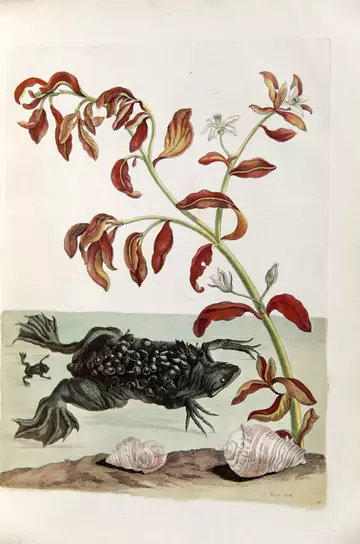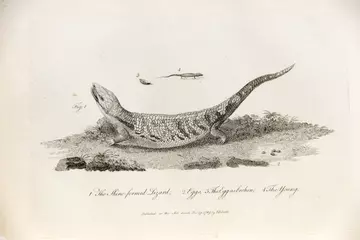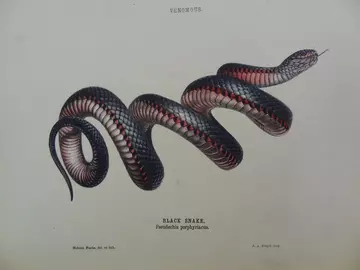Ann Sylph, MSc, MCLIP
ZSL Librarian
As we celebrate Women's History Month and International Women's Day we look at a selection of role models and trailblazers from the past. In this blog, we take a closer look at women with an interest in amphibians and reptiles - HERpers.
Joan Beauchamp Procter and Lucy Evelyn Cheesman were two women of the past associated with ZSL, both with an interest in herpetology. Joan Procter joined ZSL in 1923 becoming Curator of Reptiles and Amphibians. She designed the Reptile House in ZSL London Zoo. Do take a look at The Reptile Expert, Objectivity Video # 220 below where I talk to Brady Haran about Joan, highlighting items in our collections.
Evelyn Cheesman worked at ZSL becoming Curator of Insects 100 years ago in 1920, she later collected primarily insects but also amphibians and reptiles in the South Pacific.Long before these two women, there were women involved in exploring, discovering, observing, describing and depicting amphibians and reptiles.
Maria Sibylla Merian
Maria Sibylla Merian, 1647-1717, a German-born entomologist and artist and one of our earliest known women scientific travellers. Her careful observations of insects helped to disprove the theory of spontaneous generation and prove that insects had a life cycle. Although well-known for her work on insects she also had an interest in amphibians and reptiles.
Inspired by the exotic butterflies sent to Amsterdam from Dutch colonies, in 1699 at the age of 52 she sailed to the then Dutch colony of Surinam in South America, accompanied by her youngest daughter, Dorothea. Travelling into the dense humid forests for collecting, observing and trying to paint, she must have encountered so many difficulties.
Maria with her daughter, Dorothea’s help, spent her time in Surinam observing often colourful tropical insects, their life cycles as well as their associated food plants. She studied other animals found there including amphibians and reptiles, as well as the metamorphosis of amphibians. She became ill and had to return to Amsterdam earlier than planned where she worked on preparing a publication. Her other daughter, Johanna moved to Surinam and sent specimens to her mother who sold them on to collectors helping to cover the costs of the expedition. The results of this journey was her magnum opus Dissertation sur la génération et les transformations des insectes de Surinam, 1705.
Originally published in 1705, ZSL’s copy was published in 1726 with the text in French and Latin, this was after her death in 1717. As it is a later edition it includes additional plates depicting other animals as well as the insects (Owens, 2007). It includes an image and description of the unusual Surinam toad, Maria was the first European to describe this species. The female toad carries the fertilised eggs under a layer of skin on her back, they develop into tadpoles then froglets there before breaking through their mother’s skin to swim away.

Hélène Dumoustier de Marsilly
Hélène Dumoustier de Marsilly (born 1691) was another woman who soon after Maria Merian, was making a living by illustrating the natural world. From the 1736 Hélène was paid by the Academy of Sciences for natural history illustration at the Hotel de Uzes, the private mansion of René Anton Ferchault de Réaumur, 1683-1757, the pre-eminent naturalist of his generation before Buffon, he dominated the scientific community in Paris from the 1720s until his death in 1757. Hélène did more than illustrations, she carefully observed animals, recording her observations and documenting experiments. Hélène is increasingly being recognised for entomological contributions, she also made an important herpetological contribution but her herpetological illustrations were not published.
Mating frogs were studied in a pond in the ground of Réaumur’s Charenton house from 1736 for five years. Jan Swammerdam had described and depicted male frogs spraying the egg mass with seminal fluid but Réaumur and his observers did not see this take place. He thought that maybe the nuptial pad on the male’s fore leg was instrumental in fertilisation. As part of an experiment to investigate this possibility, Réaumur arranged one season for the male frogs to wear waxed taffeta pants to catch the seminal fluid, Hélène drew the frogs in the pants with little straps holding the pants in place. The experiment was not a success. Abandoning the idea that the nuptial pad was involved, Réaumur eventually divided up 12 pairs of frogs between 3 observers with 1 pair of frogs per jar. Hélène had two jars and in one she observed eggs emerging from the female and a fine jet looking like smoke came out from the male’s rear end, she had been successful in seeing the seminal fluid proving Swammerdam had been correct.

Katharina Barbara Rösel von Rosenhof
Katharina Barbara Rösel von Rosenhof, 1741-1804, hand coloured the plates in her father’s …Insecten-Belustigung, 1740-49, and one of the most magnificent herpetology books, focussing on frogs - Historia naturalis Ranarum nostratium/Die natürliche Historie der Frösche hiesigen Landes by August Johann Roesel von Rosenhof, (1753-)1758). We have featured this magnificent book in another blog.

Sarah Smith née Stone
Sarah Smith née Stone, 1760-1844, at the age of 17 was employed by Sir Ashton Lever to record the contents of his Leverian Museum, in Leicester Square, London. We have featured her in a previous blog. Lever’s collections were extensive containing new scientific discoveries from the Americas and Australasia, including specimens brought back on Cook’s second and third voyages around the world. Sarah was there for 30 years and her illustrations depict many newly discovered species. The paintings of Sarah Stone have scientific importance now as often they are the only record of the specimens, many of which were type specimens i.e. the specimen on which the first description is based and hence the ‘type’ of the species (Jackson, 1998). Sarah Stone illustrated John White’s Journal of a voyage to New South Wales …, 1790, depicting many Australian species which were again new to science (Jackson, 1998). Many noted naturalists appreciated her skills, she was very accurate and took great care with her depictions of animals.


Sisters, Helena Scott Forde and Harriet Scott Morgan, illustrated Gerard Krefft’s Snakes of Australia : an illustrated and descriptive catalogue of all the known species, 1869. This Australian Museum blog by Rose Docker looks at their contributions in more detail.

I do hope you find these women inspiring. They had an important role to play in discovering and explaining herpetology to a wider audience. If you have an interest in the challenges faced by women in the past when undertaking fieldwork, there is a fascinating lecture on this subject by Sandy Knapp of the Natural History Museum and President of the Linnean Society Fieldwork in fancy dress.
Explore our fellowship options to gain access to these amazing materials
References
Heard, Kate (2016). Maria Merian’s butterflies. London : Royal Collection Trust.
Jackson, Christine E. (1998). Sarah Stone : natural curiosities from the new world. London : Merrell Holberton Publ. & the Natural History Museum.
Krefft, Gerard (1869). The snakes of Australia : an illustrated and descriptive catalogue of all the known species. Sydney : Thomas Richards, Government printer.
Merian, Maria Sibylla (1726). Dissertation sur la génération et les transformations des insectes de Surinam... La Haye : Cosse.
Owens, Susan (2007). Maria Sibylla Merian : ‘Great diligence, grace and spirit’ In Amazing rare things : the art of natural history in the age of discovery, David Attenborough et al. London : Royal Collection Publications.
Réaumur, René Anton Ferchault de (1734-42). Mémoires pour servir à l'histoire des insectes. Paris : Imprimerie Royale.
Rosenhof, August Johann Röesel von (1746-61). Der monathlich-herausgegebenen Insecten-Belustigung… Nürnberg : bey dem Verfasser.
Rosenhof, August Johann Röesel von (1753-8). Historia naturalis Ranarum nostratium/ Die natürliche Historie der Frösche hiesigen Landes. Norimbergae : Fleischmann.
Swammerdan, Jan (1737-38). Biblia naturae, sive historia Insectorum. Leydae : Severinum.
Terrall, Mary (2014). Catching nature in the act : Réaumur & the practice of natural history in the eighteenth century. Chicago & London : Chicago University Press.
University of Stuttgart. Rösel von Rosenhof, Katharina Barbara in Database of scientific illustrators 1450-1950. Stuttgart : University of Stuttgart. https://dsi.hi.uni-stuttgart.de/index.php?table_name=dsi&function=details&where_field=id&where_value=4104 viewed September 2019.
White, John (1790). Journal of a voyage to New South Wales... London : Debrett.
